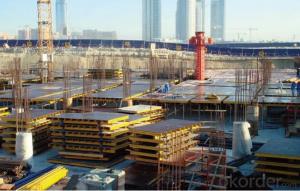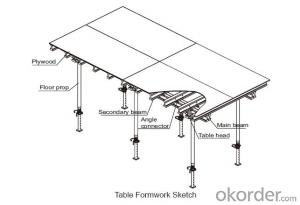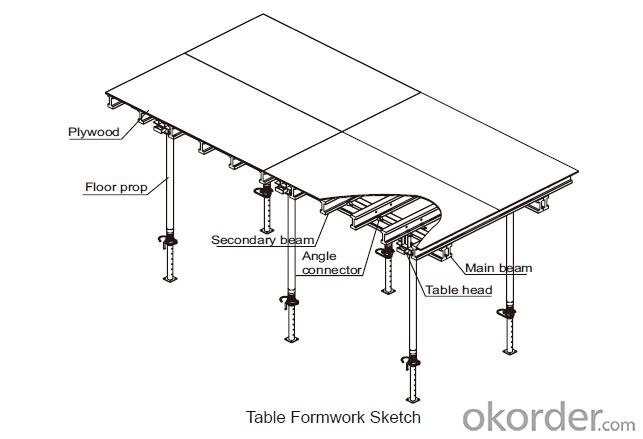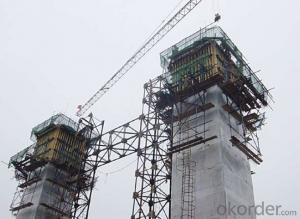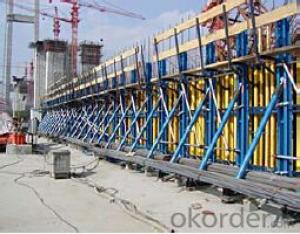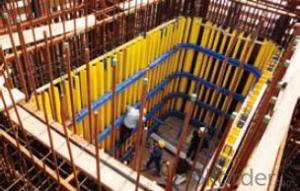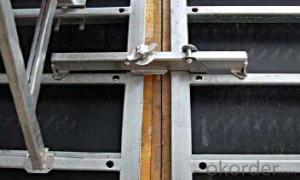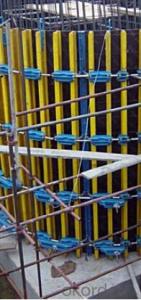Tabel-formwork for Formwork and Scaffolding system
- Loading Port:
- Tianjin
- Payment Terms:
- TT OR LC
- Min Order Qty:
- 50 m²
- Supply Capability:
- 1000 m²/month
OKorder Service Pledge
OKorder Financial Service
You Might Also Like
Tabel Formwork:
Table formwork is the most typical application for slab, with timber beam, the slab formwork is
light weight, fast and economic in the construction.
Characteristics:
◆ Simple structure, easy assembly.
◆ Flexible structure, be adapted to different support system.
◆ High construction efficiency with special system tools.
1. Lifting fork for lifting the table formwork to upper floor.
2. Trolley for moving the table formwork on floor.
◆ Flexible application with stand alone props.
◆ Safer condition with handrails.
- Q:How does steel formwork contribute to the overall constructability of the project?
- Steel formwork is a crucial component in construction projects as it plays a significant role in the overall constructability of a project. Its contribution is multifaceted and can be seen in various aspects of the construction process. Firstly, steel formwork offers excellent strength and durability, making it capable of withstanding the pressure exerted by the weight of concrete during pouring. This strength ensures that the formwork remains intact, enabling the construction of structures with complex shapes and designs. The ability to withstand extreme loads also allows for the use of thicker and heavier concrete, resulting in stronger and more durable structures. Additionally, steel formwork provides a high level of accuracy and precision in shaping concrete structures. Its rigid structure and dimensional stability allow for consistent and uniform concrete placement, ensuring that the final product meets the desired specifications. This accuracy is crucial in achieving the desired aesthetic and functional outcome of the project. Moreover, steel formwork offers versatility and adaptability. It can be easily modified, adjusted, and reused for different projects, making it a cost-effective option. This flexibility is particularly useful in situations where changes or modifications need to be made during the construction process. The ability to quickly adapt the formwork saves time, reduces material wastage, and enhances overall project efficiency. Furthermore, steel formwork contributes to the overall constructability of the project by improving construction speed. Due to its strength and stability, steel formwork allows for faster concrete pouring and setting times. This expedited construction process reduces project timelines, leading to cost savings and increased productivity. Another important contribution of steel formwork is its enhanced safety features. Steel formwork systems are designed with safety in mind, incorporating features such as handrails, access platforms, and non-slip surfaces. These features provide a safe working environment for construction workers, reducing the risk of accidents and injuries. In summary, steel formwork significantly contributes to the overall constructability of a project through its strength, accuracy, versatility, speed, and safety features. Its ability to withstand extreme loads, provide precise shaping, adapt to changes, expedite construction, and enhance safety make it an invaluable component in construction projects.
- Q:What are the different safety training requirements for steel formwork installation?
- The safety training requirements for installing steel formwork may differ depending on the regulations and guidelines established by various countries and organizations. Nevertheless, here are some typical safety training requirements that are commonly applicable: 1. All workers involved in steel formwork installation must undergo general construction safety training, which covers topics such as recognizing hazards, using personal protective equipment (PPE) correctly, fall protection, and proper lifting techniques. 2. Workers should receive specialized training on the specific techniques and procedures related to steel formwork installation. This training may include learning how to assemble and dismantle formwork properly, securing it to prevent collapse, and ensuring stability during concrete pouring. 3. Workers should be trained on operating any equipment used during steel formwork installation, such as cranes or forklifts, in a safe manner. 4. Workers should receive training on hazard communication, including understanding safety signs and labels, handling hazardous materials, and knowing how to respond to emergencies. 5. It is important for workers to be trained in first aid and CPR techniques to be prepared for any accidents or injuries that may occur during steel formwork installation. 6. If scaffolding is used during the installation process, workers should undergo scaffold safety training to understand how to assemble, use, and dismantle scaffolding safely. 7. Depending on the specific tasks involved in steel formwork installation, workers may need additional job-specific safety training. This could include training on working at heights, using power tools, or working in confined spaces. Employers and workers must comply with the relevant safety regulations and ensure that all necessary training is provided to create a safe working environment during steel formwork installation.
- Q:How does steel formwork affect the overall project cost?
- Steel formwork can have a significant impact on the overall project cost. It is generally more expensive to use steel formwork compared to other alternatives such as wood or aluminum. However, there are several factors that need to be considered when evaluating the cost-effectiveness of using steel formwork. Firstly, steel formwork is known for its durability and longevity. Unlike wood, steel formwork can be reused multiple times, which can lead to cost savings in the long run. It requires less maintenance and repairs, reducing the need for frequent replacements. This can be particularly advantageous for projects that involve repetitive use of formwork. Secondly, steel formwork offers better quality and precision in terms of concrete finishing. It provides a smoother surface and accurate dimensions, resulting in reduced need for additional finishing work. This can help save both time and money during the construction process. Moreover, steel formwork allows for faster construction compared to other types of formwork. It is quick to assemble and dismantle, enabling faster turnaround times. This can have a positive impact on the overall project schedule and potentially reduce labor costs. Additionally, steel formwork is more resistant to factors such as weather conditions, high pressure, and vibrations. This enhances the overall structural integrity of the concrete, reducing the risk of defects and potential rework. By minimizing the need for corrective actions, steel formwork can help control project costs. However, it is important to note that the cost of steel formwork can vary depending on the project size, complexity, and duration. For smaller projects with limited use of formwork, the cost difference between steel and other materials may not be significant. In such cases, it may be more cost-effective to opt for alternative formwork options. In conclusion, while steel formwork may have a higher upfront cost compared to other materials, its durability, precision, speed, and long-term reusability can contribute to cost savings throughout the project. It is essential to carefully evaluate the specific requirements and circumstances of each project to determine the most cost-effective formwork solution.
- Q:Can steel formwork be used for both horizontal and vertical concrete elements?
- Yes, steel formwork can be used for both horizontal and vertical concrete elements. Steel formwork provides strength, stability, and durability, making it suitable for a wide range of construction projects. Its versatility allows for the creation of various shapes and sizes, making it a preferred choice for both horizontal slabs and vertical walls.
- Q:Can steel formwork be used for infrastructure construction projects?
- Yes, steel formwork can be used for infrastructure construction projects. Steel formwork offers high strength, durability, and stability, making it suitable for constructing various types of infrastructure such as bridges, tunnels, dams, and highways. It can withstand heavy loads, provide smooth finish, and can be easily reused, making it a cost-effective choice for large-scale construction projects.
- Q:What are the different types of formwork spacers used in steel formwork?
- In steel formwork, there are various types of formwork spacers that are commonly used. These spacers are essential components in the construction process as they help maintain the desired spacing between the formwork and reinforcement, ensuring the structural integrity of the concrete structure. Here are some of the different types of formwork spacers used in steel formwork: 1. Plastic Spacers: Plastic spacers are widely used in steel formwork due to their lightweight, durability, and ease of installation. These spacers are typically made from high-quality plastic materials and come in various shapes and sizes to accommodate different reinforcement requirements. 2. Steel Spacers: Steel spacers are another common type of formwork spacer used in steel formwork applications. They are usually made from high-strength steel and are capable of withstanding higher loads. Steel spacers are ideal for heavy-duty applications where additional strength and durability are required. 3. Rubber Spacers: Rubber spacers are used in steel formwork to provide a cushioning effect and prevent direct contact between the reinforcement and the formwork. These spacers are suitable for applications where vibration or movement is expected, as they help absorb shocks and reduce the risk of damage. 4. Concrete Spacers: Concrete spacers are primarily used in precast concrete applications. They are made from concrete and act as support structures to maintain the correct spacing between the formwork and reinforcement. Concrete spacers are durable, easy to install, and provide excellent stability during the casting process. 5. Combination Spacers: Combination spacers are versatile spacers that combine different materials such as plastic and steel to provide enhanced strength and stability. These spacers are designed to meet specific project requirements and offer a cost-effective solution for various steel formwork applications. It is important to choose the appropriate type of formwork spacer based on the specific requirements of the project, including load capacity, spacing requirements, and environmental conditions. Consulting with a structural engineer or construction professional can help ensure the correct selection and installation of formwork spacers for optimal performance and safety.
- Q:How does steel formwork contribute to the overall fire resistance of the structure?
- The fire resistance of a structure is primarily determined by the construction materials, including the type of steel used, the insulation and coating materials applied, and the overall design. Steel formwork, however, indirectly contributes to fire resistance by facilitating the construction of fire-resistant elements. It is commonly used in concrete construction to create walls, floors, and other structural elements. By providing a stable framework for pouring concrete, it enables the creation of fire-resistant concrete walls and floors that can withstand high temperatures and prevent the spread of fire. Steel formwork can also be used to create fire-rated concrete enclosures for important areas like stairwells and shafts. These enclosures help contain the fire and provide safe escape routes for occupants during emergencies. Additionally, steel formwork can incorporate fire-resistant materials such as insulation boards or coatings, which add another layer of fire protection to the resulting structure. Overall, although steel formwork itself does not directly contribute to fire resistance, it plays a crucial role in enabling the construction of fire-resistant elements and incorporating fire protection materials. This indirectly enhances the overall fire resistance and safety of the structure.
- Q:How does steel formwork affect the overall long-term performance of the structure?
- The overall long-term performance of a structure can be significantly influenced by the use of steel formwork. One of the main advantages of steel formwork is its durability, as steel is a robust and resilient material that can endure heavy loads and extreme weather conditions, thereby ensuring the structure's longevity. The utilization of steel formwork provides a rigid and stable framework for pouring concrete. This, in turn, leads to a more precise and accurate construction process, ultimately resulting in a stronger and higher quality structure. Moreover, steel formwork allows for quicker construction as it can be easily assembled and disassembled, reducing the overall construction time. Additionally, steel formwork offers a smooth and flat surface finish, which is vital for the aesthetic appeal of the structure. The smooth surface reduces the need for additional finishing work, saving both time and money. Furthermore, the use of steel formwork guarantees proper support and reinforcement for the concrete, preventing issues such as cracking, sagging, or deformation over time. Another advantage of steel formwork is its reusability. Unlike traditional wooden formwork, steel formwork can be used multiple times, resulting in cost savings and a reduced environmental impact. The durability and strength of steel formwork enable it to endure the wear and tear of multiple uses, making it a more sustainable option. To summarize, steel formwork has a positive impact on the overall long-term performance of a structure by providing durability, strength, accuracy, and reusability. It ensures a construction process of high quality, resulting in a robust and aesthetically pleasing structure that can withstand the test of time.
- Q:What are the different types of coatings available for steel formwork?
- Steel formwork has a variety of coatings available, each with its own unique advantages and applications. 1. Paint coatings: These coatings offer basic corrosion protection and can be applied in different colors. They are affordable and easy to apply, making them a popular choice for general-purpose formwork. 2. Galvanized coatings: Galvanizing involves applying a zinc layer to the steel surface, providing excellent corrosion resistance. It is ideal for formwork in harsh environments or requiring long-term durability. 3. Epoxy coatings: Epoxy coatings provide superior chemical resistance and durability compared to other coatings. They are commonly used in formwork exposed to aggressive substances or requiring high hygiene standards, like in the food industry. 4. Powder coatings: Powder coatings are applied as a dry powder and then baked, resulting in a hard, durable finish. They have excellent impact resistance and come in a wide range of colors. They are often used in formwork subject to significant wear and tear. 5. Polymer coatings: Polymer coatings, such as polyurethane or polyethylene, create a protective layer over the steel surface. They offer good resistance to abrasion, impact, and chemicals, making them suitable for demanding applications. 6. Thermal spray coatings: Thermal spray coatings involve applying molten materials like zinc or aluminum onto the steel surface. They provide exceptional corrosion resistance and are commonly used in marine or offshore formwork. When choosing the right coating for steel formwork, it is important to consider factors such as intended use, environmental conditions, and budget. Consulting coating specialists or manufacturers can help determine the best coating for specific applications.
- Q:Can steel formwork be used for both above-grade and below-grade walls?
- Yes, steel formwork can be used for both above-grade and below-grade walls. Steel formwork is highly versatile and can be used in various construction applications, including both above-grade and below-grade walls. Its strength and durability make it suitable for withstanding the pressure and weight of the concrete used in these walls. Additionally, steel formwork can be easily assembled and disassembled, allowing for efficient construction processes for both types of walls. Whether it is for basement walls or exterior walls above ground, steel formwork can provide the necessary support and shape for the concrete to be poured, resulting in strong and long-lasting structures.
1. Manufacturer Overview |
|
|---|---|
| Location | |
| Year Established | |
| Annual Output Value | |
| Main Markets | |
| Company Certifications | |
2. Manufacturer Certificates |
|
|---|---|
| a) Certification Name | |
| Range | |
| Reference | |
| Validity Period | |
3. Manufacturer Capability |
|
|---|---|
| a)Trade Capacity | |
| Nearest Port | |
| Export Percentage | |
| No.of Employees in Trade Department | |
| Language Spoken: | |
| b)Factory Information | |
| Factory Size: | |
| No. of Production Lines | |
| Contract Manufacturing | |
| Product Price Range | |
Send your message to us
Tabel-formwork for Formwork and Scaffolding system
- Loading Port:
- Tianjin
- Payment Terms:
- TT OR LC
- Min Order Qty:
- 50 m²
- Supply Capability:
- 1000 m²/month
OKorder Service Pledge
OKorder Financial Service
Similar products
Hot products
Hot Searches
Related keywords
